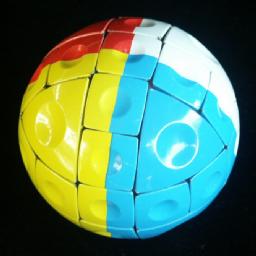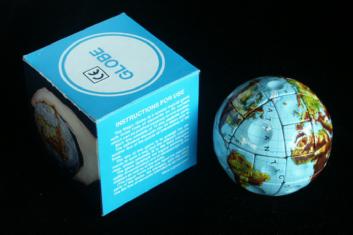





This sliding-piece puzzle is a ball with three intersecting rings of moving pieces which divide the ball into eights. There are 12 square shaped pieces each ring, making 30 pieces in all because there are 6 places where the rings intersect. There is no space so the pieces do not move singly. Instead, all 12 pieces of a ring are shifted as one.
Note that the pieces come in inseparable antipodal pairs; pieces on opposite sides of the puzzle will always stay that way. Solving a piece on one side will automatically solve the piece on the other.
There are several versions of this puzzle, which differ only in the colour scheme. The Hungarian Globe (also known as Varázs Gömb, Globus Gömb, or Földgömb) simply has a map of the earth on it, like a proper globe. The Equator version of that puzzle has a simple colour scheme. Four quarters of the puzzle have a different colour. Thus the pieces at the poles have 4 colours, the pieces on the vertical rings have two, the remaining pieces only one. The Hungarian Globe and the Equator are both made of plastic with tin metal shells covering all the pieces, which makes it feel quite cool and solid. The I.Q. Ball, shown in the third picture, has six sets of 5 tiles. Each set has one colour, some with different symbols.
This puzzle should not be confused with the Massage Ball 2 which not only has a different colour scheme, it also allows two halves of the ball to rotate with respect to each other. Another related puzzle is the Mozaika where two halves on any of the three axes can rotate.
The Equator and Hungarian Globe were invented by Ferenc Molnár. Its original patent is HU 186,541, and the equivalent British patent GB 2,088,728 was published on 16 June 1982.
The I.Q. Ball was invented by Ming-Zen Liu and its US patent US 5,114,148 was published on 19 May 1982.
Let's consider the Hungarian Globe first. There are 15 pairs of pieces, which can be placed in a position in 8 ways, giving a maximum of 15!·815 positions. This limit is not reached because:
This leaves 15!·815/4 = 11,502,425,383,685,056,364,544,000 or about 1.1·1025 positions. Note that the second constraint arises from the fact that moving a ring one tile is an odd permutation on the 12 tiles and also an odd permutation on the 6 tile pairs. This means it is impossible for example to swap two antipodal tiles without moving anything else (though on the Equator puzzle that situation does occur because that has identical tile pairs).
The Equator is simpler. Here the limit of 15!·815 is not reached because:
This leaves 15!/(2!·2!·5!·5!) · 811·24 = 3,120,232,580,209,704,960 or 3.1·1018 positions.
 The Hungarian Globe will naturally be held with the North pole on top.
On the Equator puzzle the 4-coloured pieces are considered to be the
poles, so it is held so that the 4 top triangles have different colours.
The equatorial ring and one of the vertical rings intersect on the front
and the back of the puzzle.
The Hungarian Globe will naturally be held with the North pole on top.
On the Equator puzzle the 4-coloured pieces are considered to be the
poles, so it is held so that the 4 top triangles have different colours.
The equatorial ring and one of the vertical rings intersect on the front
and the back of the puzzle.Phase 1: Solve the front vertical ring (except pole/equator pieces).
| Twist needed | Up 1 square | Up 2 squares | ||
| None | R1 D1 L1 U1 | R1 D2 L1 U2 | ||
| Clockwise | L3 U2 C3 D2 | L3 U1 C3 D1 | ||
| Half turn | R1 U5 R5 D5 | R1 U4 R5 D4 | ||
| Anti-clockwise | R3 U2 A3 D2 | R3 U1 A3 D1 |
Phase 2: Solve the other vertical ring.
This is done exactly the same way as the first vertical ring. Rotate the whole
puzzle left or right a quarter turn, and repeat Phase 1. Afterwards
the first ring will not have been disturbed except that it may have been
rotated by a quarter or a half turn. Simply re-align it when you have
solved the second ring.
Phase 3: Solve the poles.
| Twist needed | |
| None | R1 D3 L1 U3 |
| Clockwise | A3 L3 C3 |
| Half turn | R1 U3 R5 D3 |
| Anti-clockwise | C3 R3 A3 |
Phase 4: Orient (most of) the equatorial pieces.
In this phase the actual position of the pieces on the equator is ignored.
| Clockwise | U3 R3 C3 R? L3 A3 L3 D3 |
| Half turn | U6 R? D6 |
| Anti-clockwise | U3 L3 A3 R? R3 C3 R3 D3 |
Phase 5: Position the equatorial pieces.
The phase is actually quite easy, but hard to explain.